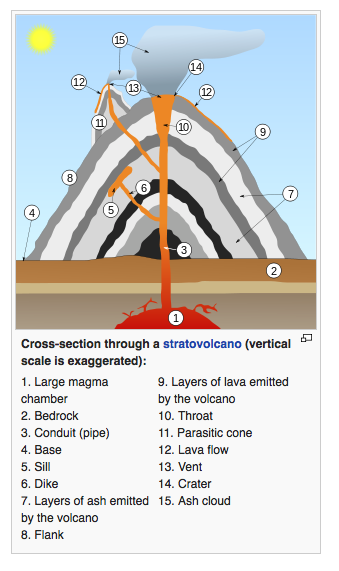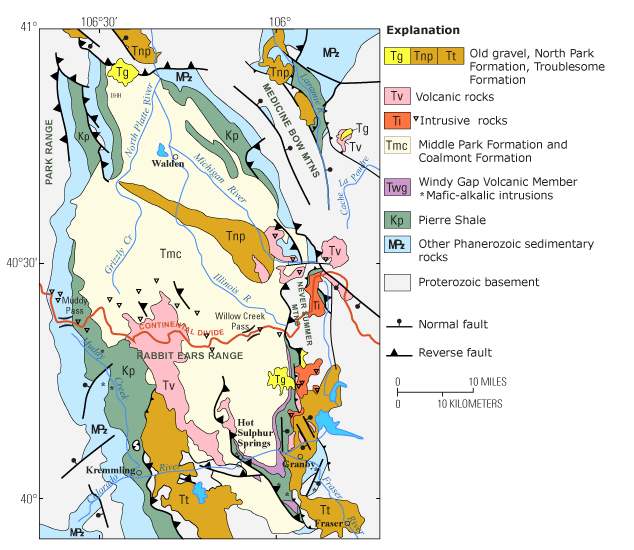 Earth Science Lesson
Earth Science Lesson
A volcano is a rupture on the crust of a planetary-mass object, such as Earth, that allows hot lava, volcanic ash, and gases to escape from a magma chamber below the surface.
The dark rock of Lava Cliffs is welded tuff. Tuff is an igneous rock that forms from the products of an explosive volcanic eruption. In these eruptions the volcano blasts rock, ash, magma and other materials from its vent. This ejecta travels through the air and falls back to Earth in the area surrounding the volcano. If the ejected material is compacted and cemented into a rock that rock will be called "tuff”.
Tuff is usually thickest near the volcanic vent and decreases in thickness with distance from the volcano. Instead of being a "layer" a tuff is usually a "lens-shaped" deposit. Tuff can also be thickest on the downwind side of the vent or on the side of the vent where the blast was directed.
Some tuff deposits are hundreds of meters thick and have a total eruptive volume of many cubic miles. That enormous thickness can be from a single eruptive blast or more commonly from successive surges of a single eruption - or eruptions that were separated by long periods of time.
Sometimes the ejecta is hot enough when it lands the particles are soft and sticky. These materials "weld" together upon impact or upon compaction. The rock formed from this hot ejecta is known as a "welded tuff" - because the ejected particles are welded together. Some deposits might contain welded tuff near the vent and unwelded tuff at a distance where smaller, cooler particles fell to the ground.
The liquid rock material escaping from a volcano is called lava. The chemical composition of the lava affects its viscosity, which limits the speed and distance it can flow away from the volcanic vent. This lava property also governs the shape of the volcano. The main chemical constituent affecting the physical properties of lava is the amount of SiO2 (silica).
Igneous rocks (lava’s and their intrusive counterparts) are classified by their silica content. Lavas that are relatively low in silica (45-53%) are the least viscous. They flow quickly and for many kilometers away from the volcanic vent. These are the basaltic lavas – by volume the most abundant lava type found on earth. Lavas which are relatively high in silica content (70-78%) are the most viscous. These lavas flow very slowly and form expanding domes which plug up volcanic vents, bottling up the pressure and trapping the expanding gases. These lavas are classified as rhyolites.
In some cases, when the lava becomes very viscous the lava plugs the volcano vents under which huge pressures build up due to escaping gas. These pressures can cause the volcano to explode, leaving only the outer shell of the original volcanic rim surviving. Some volcanoes empty their magma chambers after an eruption, and the mass of the volcano causes it to collapse in on itself. These large collapsed volcanoes are known as calderas.
The lava you see here at the Lava Cliffs is the result of an explosion several miles away in the volcanic vents of the Never Summer Mountains. When the vents became clogged with thick, gooey lava not all of the molten lava flowed as a liquid. Some exploded out as a fast-moving avalanche of molten rock and gas. When the flow stopped it fused itself into a solid mass.

Logging Tasks
You must answer these questions and e-mail me your answers. Do NOT post answers in your log (even if encrypted) or it will be deleted. Logs without verification will also be deleted. Photos are not required, but are encouraged (without spoilers).
Send me a note with :
- The text "GC5YQCF Earthcache" on the first line
- The number of people in your group.
- Based on information above and what you see at the site, how long ago did this eruption occur?
- Based on information above and what you see at the site, estimate the distance the lava traveled?
- Do you think the lava was closer to the least or most viscous? Why?
References
The above information was obtained using:
Rocky Mountain National Park is located west of Estes Park and north and east of Grand Lake. This is a fee area of the National Park Service, and costs $20 per vehicle. This fee is covered in the Rocky Mountain National Park Annual Pass, the Rocky Mountain National Park/Arapaho National Recreation Area Annual Pass, and the America the Beautiful Pass. The park is open 24 hours a day, 365 days a year. Please remember that all geologic features within the borders of Rocky Mountain National Park are protected by law, as are all natural and historic features. Please do not disturb, damage, or remove any rocks, plants, or animals.
For the most updated fees check this link. Follow all park rules and regulations. You do not need to leave the parking lot area to complete this earthcache.
